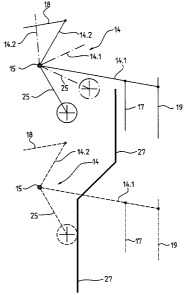Some of the information on this Web page has been provided by external sources. The Government of Canada is not responsible for the accuracy, reliability or currency of the information supplied by external sources. Users wishing to rely upon this information should consult directly with the source of the information. Content provided by external sources is not subject to official languages, privacy and accessibility requirements.
Any discrepancies in the text and image of the Claims and Abstract are due to differing posting times. Text of the Claims and Abstract are posted:
| (12) Patent: | (11) CA 2404677 |
|---|---|
| (54) English Title: | DEVICE FOR BLOCKING A SAFETY BRAKE FOR LIFT |
| (54) French Title: | DISPOSITIF DE BLOCAGE DU FREIN DE SECURITE D'UN ASCENSEUR |
| Status: | Deemed expired |
| (51) International Patent Classification (IPC): |
|
|---|---|
| (72) Inventors : |
|
| (73) Owners : |
|
| (71) Applicants : |
|
| (74) Agent: | RICHES, MCKENZIE & HERBERT LLP |
| (74) Associate agent: | |
| (45) Issued: | 2010-07-20 |
| (22) Filed Date: | 2002-09-24 |
| (41) Open to Public Inspection: | 2003-03-28 |
| Examination requested: | 2007-07-10 |
| Availability of licence: | N/A |
| (25) Language of filing: | English |
| Patent Cooperation Treaty (PCT): | No |
|---|
| (30) Application Priority Data: | ||||||
|---|---|---|---|---|---|---|
|
In this lift equipment a lift cage (2) is on the way down, wherein a halt at the bottom storey is scheduled. If the lift cage (2) does not halt at the bottom storey according to plan, the lift cage (2) in its further travel is caught by buffers (26). In that case a safety brake (16) can be tripped due to the inertia of a speed limiter (13) and a limiter cable (19). So that the undesired tripping of the safety brake (16) can be avoided in the case of buffer travel, there is provided in the lift shaft (1) a blocking element (27) which blocks the movement of a blocking lever (25) as soon as the lift cage (2) has gone down past the bottom storey. The blocked blocking lever (25) blocks one double lever (14) and, by way of a linkage (18), the other double lever (14). Tripping of the safety brake (16) is thus precluded.
Dans cet ascenseur, une cabine (2) descend jusqu'à un arrêt, prévu au niveau inférieur. Si la cabine (2) ne s'arrête pas au niveau inférieur comme prévu, des amortisseurs (26) immobilisent la cabine (2) après qu'elle a dépassé sa course nominale. En pareil cas, un frein de sécurité (16) peut se déclencher du fait de l'inertie d'un limiteur de vitesse (13) et d'un câble de freinage (19). Pour éviter le déclenchement intempestif du frein de sécurité (16), en cas de course jusqu'aux amortisseurs, la gaine d'ascenseur (1) est pourvue d'un élément de verrouillage (27) qui empêche le déplacement d'un levier de blocage (25) dès que la cabine (2) dépasse le niveau inférieur. Étant immobilisé, le levier de blocage (25) verrouille un double levier (14) et, grâce à une timonerie (18), un autre double levier (14). Le déclenchement du frein de sécurité (16) est ainsi interdit.
Note: Claims are shown in the official language in which they were submitted.
Note: Descriptions are shown in the official language in which they were submitted.

For a clearer understanding of the status of the application/patent presented on this page, the site Disclaimer , as well as the definitions for Patent , Administrative Status , Maintenance Fee and Payment History should be consulted.
| Title | Date |
|---|---|
| Forecasted Issue Date | 2010-07-20 |
| (22) Filed | 2002-09-24 |
| (41) Open to Public Inspection | 2003-03-28 |
| Examination Requested | 2007-07-10 |
| (45) Issued | 2010-07-20 |
| Deemed Expired | 2013-09-24 |
There is no abandonment history.
| Fee Type | Anniversary Year | Due Date | Amount Paid | Paid Date |
|---|---|---|---|---|
| Registration of a document - section 124 | $100.00 | 2002-09-24 | ||
| Application Fee | $300.00 | 2002-09-24 | ||
| Maintenance Fee - Application - New Act | 2 | 2004-09-24 | $100.00 | 2004-08-25 |
| Maintenance Fee - Application - New Act | 3 | 2005-09-26 | $100.00 | 2005-08-29 |
| Maintenance Fee - Application - New Act | 4 | 2006-09-25 | $100.00 | 2006-08-31 |
| Request for Examination | $800.00 | 2007-07-10 | ||
| Maintenance Fee - Application - New Act | 5 | 2007-09-24 | $200.00 | 2007-08-30 |
| Maintenance Fee - Application - New Act | 6 | 2008-09-24 | $200.00 | 2008-08-27 |
| Maintenance Fee - Application - New Act | 7 | 2009-09-24 | $200.00 | 2009-08-27 |
| Final Fee | $300.00 | 2010-05-04 | ||
| Maintenance Fee - Patent - New Act | 8 | 2010-09-24 | $200.00 | 2010-09-09 |
| Maintenance Fee - Patent - New Act | 9 | 2011-09-26 | $200.00 | 2011-09-08 |
Note: Records showing the ownership history in alphabetical order.
| Current Owners on Record |
|---|
| INVENTIO AG |
| Past Owners on Record |
|---|
| HUGEL, STEFAN |
| MAURY, JULIEN |